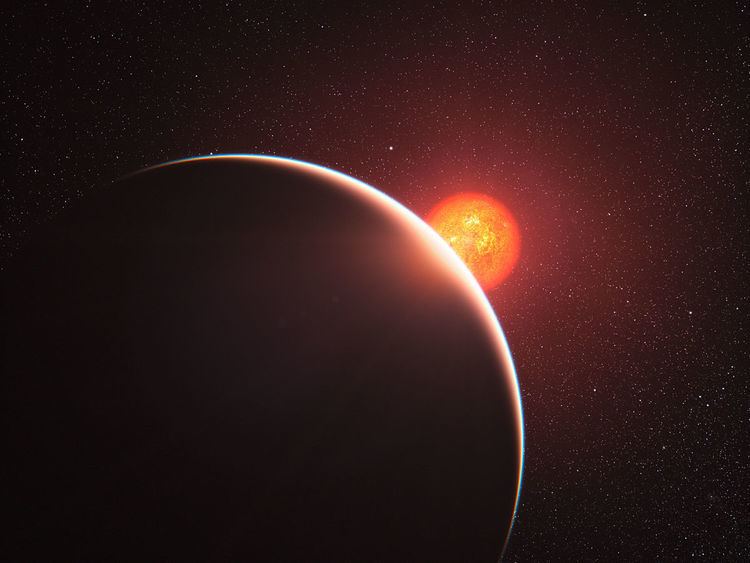Discovery date December 16, 2009 Discovery status Published | Other detection methods Radial velocity | |
 | ||
Discoverer(s) David Charbonneau, et al. Discovery site Fred Lawrence Whipple Observatory | ||
Gliese 1214 b (often shortened to GJ 1214 b) is an exoplanet that orbits the star Gliese 1214, and was discovered in December 2009. Its parent star is 42 light-years from the Sun, in the constellation Ophiuchus. As of 2015, GJ 1214 b is the most likely known candidate for being an ocean planet. For that reason, scientists have nicknamed the planet "the waterworld".
Contents
It is a super-Earth, meaning it is larger than Earth but is significantly smaller (in mass and radius) than the gas giants of the Solar System. After COROT-7b, it was the second super-Earth to be known and is the first of a new class of planets with small size and relatively low density. GJ 1214 b is also significant because its parent star is relatively near the Sun and because it transits (crosses in front of) that parent star, which allows the planet's atmosphere to be studied using spectroscopic methods.
In December 2013, NASA reported that clouds may have been detected in the atmosphere of GJ 1214 b.
Facts
Detection
GJ 1214 b was first detected by the MEarth Project, which searches for the small drops in brightness that can occur when an orbiting planet briefly passes in front of its parent star. In early 2009, the astronomers running the project noticed that the star GJ 1214 appeared to show drops in brightness of that sort. They then observed the star more closely and confirmed that it dimmed by roughly 1.5% every 1.58 days. Follow-up radial-velocity measurements were then made with the HARPS spectrograph on the ESO's 3.6-meter telescope at La Silla, Chile; those measurements succeeded in providing independent evidence for the reality of the planet. A paper was then published in Nature announcing the planet and giving estimates of its mass, radius, and orbital parameters.
Features
The radius of GJ 1214 b can be inferred from the amount of dimming seen when the planet crosses in front of its parent star as viewed from Earth. The mass of the planet can be inferred from sensitive observations of the parent star's radial velocity, measured through small shifts in stellar spectral lines due to the Doppler effect. Given the planet's mass and radius, its density can be calculated. Through a comparison with theoretical models, the density in turn provides limited but highly useful information about the composition and structure of the planet.
Due to the relatively small size of GJ 1214 b's parent star, it is feasible to perform spectroscopic observations during planetary transits. By comparing the observed spectrum before and during transits, the spectrum of the planetary atmosphere can be inferred. In December 2010, a study was published showing the spectrum to be largely featureless over the wavelength range of 750–1000 nm. Because a thick and cloud-free hydrogen-rich atmosphere would have produced detectable spectral features, such an atmosphere appears to be ruled out. Although no clear signs were observed of water vapor or any other molecule, the authors of the study believe the planet may have an atmosphere composed mainly of water vapor. Another possibility is that there may be a thick layer of high clouds, which absorbs the starlight. Further observations are necessary to determine the composition of its atmosphere.
Because of the estimated old age of the planetary system and the calculated hydrodynamic escape rate of 9×105 kg s−1, scientists conclude that there has been a significant atmospheric loss during the lifetime of the planet and any current atmosphere cannot be primordial.
GJ 1214 b may be cooler than any other known transiting planet prior to the discovery of Kepler-16b in 2011 by the Kepler mission. Its equilibrium temperature could be between approximately 393–555 K (120–282 °C or 248–540 °F), depending on how much of the star's radiation is reflected back into space.
Speculation based on planetary models
While very little is known about GJ 1214 b, that does not prevent wild speculation in the press. On the basis of planetary models it has been suggested that GJ 1214 b has a relatively thick gaseous envelope. It is possible to propose structures by assuming different compositions, guided by scenarios for the formation and evolution of the planet. GJ 1214 b could be a rocky planet with an outgassed hydrogen-rich atmosphere, a mini-Neptune, or an ocean planet. If it is a water world, it could possibly be thought of as a bigger and hotter version of Jupiter's Galilean moons. While no scientist has stated to believe GJ 1214 b is an ocean planet, if GJ 1214 b is assumed to be an ocean planet, i.e. the interior is assumed to be composed primarily of a water core surrounded by more water, proportions of the total mass consistent with the mass and radius are ~25% rock and ~75% water, covered by a thick envelope of gases such as hydrogen and helium (~0.05%). Water planets could result from inward planetary migration and originate as protoplanets that formed from volatile ice-rich material beyond the snow-line but that never attained masses sufficient to accrete large amounts of H/He nebular gas. Because of the varying pressure at depth, models of a water world include "steam, liquid, superfluid, high-pressure ices, and plasma phases" of water. Some of the solid-phase water could be in the form of ice VII.
